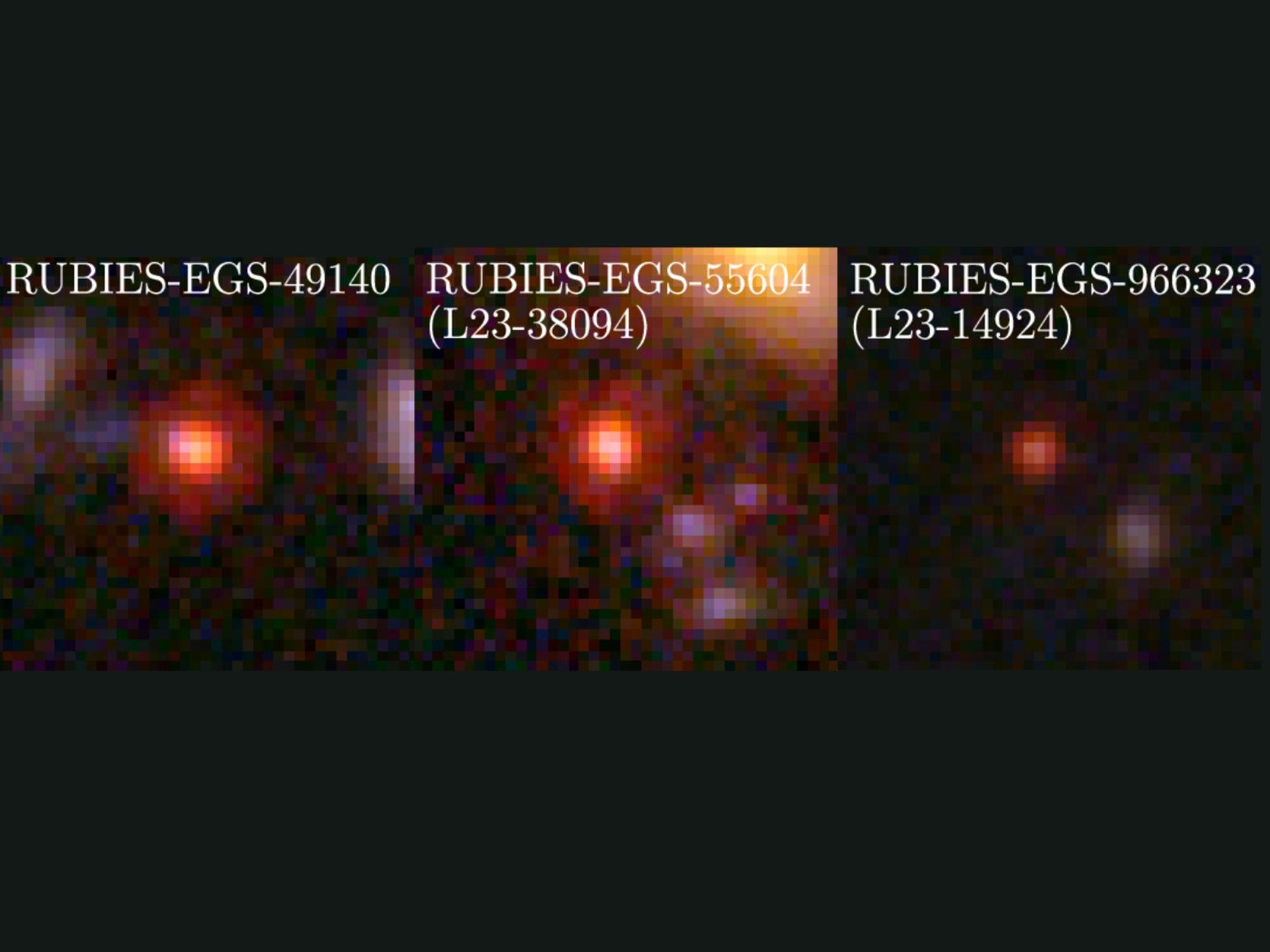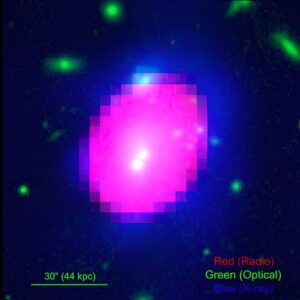Researchers investigated three mysterious objects in the early universe. Shown here are their color images, composed of three NIRCam filter strips aboard the James Webb Space Telescope. They are remarkably compact at red wavelengths (earning them the term “little red dots”), with some evidence of spatial structure at blue wavelengths. Credit: Bingjie Wang/Penn State; JWST/NIRSspec.
A recent discovery by NASA’s James Webb Space Telescope (JWST) has confirmed that luminous, very red objects previously found in the early universe challenge conventional thinking about the origin and evolution of galaxies and their supermassive black holes.
An international team led by Penn State researchers, using the NIRSpec instrument aboard JWST as part of the RUBIES survey, has identified three mysterious objects in the early universe, about 600–800 million years after the Big Bang, when the universe was only 5% of its current size your age They announced the discovery today, June 27 at Astrophysical Journal Letters.
The team studied spectral measurements, or intensities, of different wavelengths of light emitted by the objects. Their analysis found signs of “old” stars, hundreds of millions of years old, much older than expected in a young universe.
The researchers said they were also surprised to find traces of huge supermassive black holes in the same objects, estimating that they are 100 to 1,000 times more massive than the supermassive black hole in our own Milky Way. Neither is expected in current models of galaxy growth and supermassive black hole formation, which expect galaxies and their black holes to grow together over billions of years of cosmic history.
“We confirmed that they appear to be full of ancient stars – hundreds of millions of years old – in a universe that is only 600-800 million years old. Remarkably, these objects hold the record for the earliest signatures of old starlight,” said Bingjie Wang, a postdoctoral fellow at Penn State and lead author of the paper.
“It was completely unexpected to find old stars in a very young universe. The standard models of cosmology and galaxy formation have been incredibly successful, but these luminous objects don’t fit quite comfortably into those theories.”
Researchers first noticed the massive objects in July 2022, when the initial data set was released by JWST. The team published a paper in Nature a few months later announcing the existence of the objects.
At the time, the researchers suspected the objects were galaxies, but they followed up their analysis by taking spectra to better understand the objects’ true distances, as well as the sources powering their immense light.
The researchers then used the new data to paint a clearer picture of what galaxies look like and what’s inside them. Not only did the team confirm that the objects were indeed galaxies near the beginning of time, but they also found evidence of surprisingly large supermassive black holes and a surprisingly old population of stars.
“It’s very confusing,” said Joel Leha, assistant professor of astronomy and astrophysics at Penn State and co-author of both papers. “You could make this uncomfortably fit with our current model of the universe, but only if we induced some exotic, insanely fast formation at the beginning of time. This is without a doubt the strangest and most interesting set of objects I have seen in my career.”
JWST is equipped with infrared sensing instruments capable of detecting light that was emitted by the most ancient stars and galaxies. Essentially, the telescope allows scientists to see back in time approximately 13.5 billion years, near the beginning of the universe as we know it, Leia said.
One challenge to ancient light analysis is that it can be difficult to distinguish between the types of objects that could have emitted the light. In the case of these early objects, they have clear characteristics of both supermassive black holes and old stars.
However, Wang explained, it’s still not clear how much of the observed light comes from each of them — meaning that these could be early galaxies that are unexpectedly old and more massive than even our own Milky Way forming much earlier than models predict, or they may be more normal-mass galaxies with “supermassive” black holes, roughly 100 to 1000 times more massive than such a galaxy would have today.
“Distinguishing between light from material falling into a black hole and light emitted by stars in these small, distant objects is a challenge,” Wang said. “This inability to distinguish the current data set leaves ample room for interpretation of these intriguing objects. Honestly, it’s exciting to have so much of this mystery left to unravel.”
Besides their inexplicable mass and age, if some of the light is indeed from supermassive black holes, then they are not normal supermassive black holes either. They produce far more ultraviolet photons than expected, and similar objects studied with other instruments lack the hallmarks of supermassive black holes, such as hot dust and bright X-ray emission. But perhaps the most surprising thing, the researchers said, is how massive they look.
“Typically, supermassive black holes are associated with galaxies,” Leia said. “They grow up together and go through all their major life experiences together. But here we have a fully formed adult black hole living inside what should be a baby galaxy. It doesn’t really make sense because these things are supposed to grow together, or so we thought.”
Researchers were also baffled by the incredibly small sizes of these systems, only a few hundred light-years across, roughly 1,000 times smaller than our own Milky Way. There are about as many stars as our own Milky Way galaxy—somewhere between 10 billion and 1 trillion stars—but contained in a volume 1,000 times smaller than the Milky Way.
Leia explained that if you took the Milky Way and compressed it to the size of the galaxies they found, the nearest star would be almost in our solar system. The supermassive black hole at the center of the Milky Way, about 26,000 light-years away, will be only about 26 light-years from Earth and visible in the sky as a giant pillar of light.
“These early galaxies would be so dense with stars — stars that must have formed in a way we’ve never seen, under conditions we’d never expect during a period we’d never expect to see them.” Leia said. “And for some reason the universe stopped creating objects like these after only a few billion years. They are unique to the early universe.”
The researchers hope to follow up with more observations, which they say could help explain some of the mysteries of the objects. They plan to capture deeper spectra by pointing the telescope at the objects for extended periods of time, which will help disentangle the emission from the stars and the potential supermassive black hole by identifying the specific absorption signatures that would be present in each.
“There’s another way we can make a breakthrough, and it’s the right idea,” Leia said. “We have all these puzzle pieces and they only fit if we ignore the fact that some of them break. This problem is susceptible to a stroke of genius that has so far eluded us, all our collaborators, and the entire scientific community.”
More info:
Bingjie 冰洁 Wang 王 et al, RUBIES: Evolved stellar populations with extended formation histories at z ∼ 7–8 in candidate massive galaxies identified with JWST/NIRSpec, The Astrophysical Journal Letters (2024). DOI: 10.3847/2041-8213/ad55f7
Provided by The Pennsylvania State University
Quote: Tiny Bright Objects Found in Universe’s Dawn Trouble Scientists (2024, June 28), Retrieved June 28, 2024, from https://phys.org/news/2024-06-tiny-bright-dawn -universe-baffle.html
This document is subject to copyright. Except for any fair dealing for the purposes of private study or research, no part may be reproduced without written permission. The content is provided for informational purposes only.



